
9
8.1.3 Common substances
Substance
Viscosity (mPa·s)
Temperature (°C)
Benzene
0.604
25
Water
1.0016
20
Mercury
1.526
25
Whole milk
2.12
20
Olive oil
56.2
26
Reference source: https://en.wikipedia.org/wiki/Viscosity
8.2 Requirements of container and Installation Instruction
The tested container is divided into 3 categories: insulation materials, metal, water-absorbing non-metallic
1. Could either glue the probe or use a support to fix the probe on the outside of the container.
2. Avoid metal materials at the probe mounting site so as not to affect the detection.
3. The place where the probe is installed should avoid the liquid and the flow path of the liquid.
4. There should be no silt or other debris inside the container where the low-level probe is directly facing, so as not to affect the detection.
8.2.1 The first usage: Insulation Materials container
Containers made of non-metallic materials with flat surface, uniform thickness, tight material and good insulation performance; such as glass,
plastic, non-absorbent ceramic, acrylic, rubber and other materials or their composite materials.
Install method:
1.
If the wall of the container where the measuring probe is installed is a multi-layer material, the layers should be in close contact without
bubbles or gas inter-layers. The inside and outside surfaces of the container should be flat.
2.
The thickness of container: 0
-
20mm
3.
Tank type:
spherical tank, horizontal tank, vertical tank, etc.
4.
The container of this kinds of materials is as following Picture 1:
Picture 1
Example of the installation method of the sensor with the non-metallic container
R718VA
R718VA
Plastic, glass, ceramics, etc. non-metallic container
Mucilage glue
































